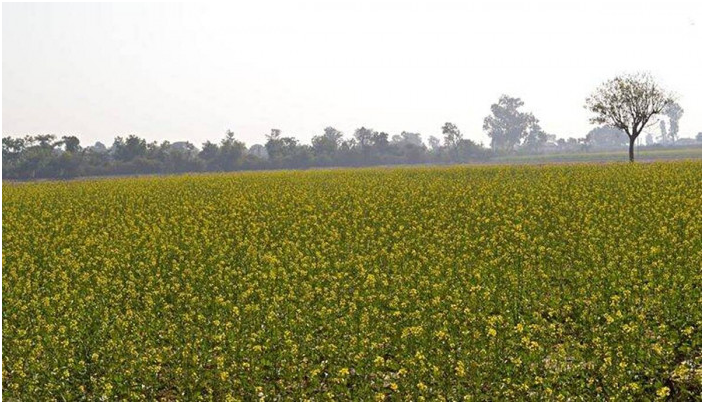GEAC approves commercial cultivation of GM Mustard (GS Paper 3, Science and Tech)

Why in news?
- The Genetic Engineering Appraisal Committee (GEAC) that functions under the Union Environment Ministry has yet again cleared the proposal for the commercial cultivation of genetically modified (GM) mustard.
What exactly is hybrid mustard?
- Hybridisation involves crossing two genetically dissimilar plant varieties that can even be from the same species. The first-generation (F1) offspring from such crosses tend to have higher yields than what either parent can individually give.
- Such hybridisationisn’t easy in mustard, as its flowers have both female (pistil) and male (stamen) reproductive organs, making the plants largely self-pollinating.
- Since the eggs of one plant cannot be fertilised by the pollen grains from another, it limits the scope for developing hybrids, unlike in cotton, maize or tomato, where this can be done through simple emasculation or physical removal of anthers.
So, how has hybridisation been achieved in mustard?
- By genetic modification (GM). Scientists at Delhi University’s Centre for Genetic Manipulation of Crop Plants (CGMCP) have developed the hybrid mustard DMH-11 containing two alien genes isolated from a soil bacterium called Bacillus amyloliquefaciens.
- The first gene (‘barnase’) codes for a protein that impairs pollen production and renders the plant into which it is incorporated male-sterile. This plant is then crossed with a fertile parental line containing, in turn, the second ‘barstar’ gene that blocks the action of the barnase gene.
- The resultant F1 progeny is both high-yielding and also capable of producing seed/ grain, thanks to the barstar gene in the second fertile line.
- The CGMCP scientists have deployed the barnase-barstar GM technology to create what they say is a robust and viable hybridisation system in mustard. This system was used to develop DMH-11 by crossing a popular Indian mustard variety ‘Varuna’ (the barnase line) with an East European ‘Early Heera-2’ mutant (barstar).
- DMH-11 is claimed to have shown an average 28% yield increase over Varuna in contained field trials carried out by the Indian Council of Agricultural Research (ICAR).
Environmental release:
- A GEAC meeting held recently allowed the environmental release of two varieties of genetically engineered mustard, so that it can be used for developing new parental lines and hybrids under the supervision of the Indian Council of Agriculture Research (ICAR).
- The environmental release of mustard hybrid Dhara Mustard Hybrid (DMH-11) for its seed production and testing as per existing ICAR guidelines and other extant rules/regulations prior to commercial release.
- The field demonstration studies on the effect of GE mustard on honey bees and other pollinators was also allowed to be conducted.
Conditions:
- Considering the application of the Centre for Genetic Manipulation of Crop Plants, the GEAC also set certain conditions for the clearance.
- It includes that the approval is for a limited period of four years and is renewable for two years at a time based on compliance report. External experts will visit the growing sites of the crop at least once during each season.
- Applicant shall deposit 100 grams each of approved hybrids as well as their parental lines with the ICAR-National Bureau of Plant Genetic Resources and communicate the same to GEAC within 30 days of issue of this clearance letter for purposes of future reference in case of trade, traceability and dispute on account of ownership.
- The applicant should also develop and deposit the DNA fingerprints of the approved varieties to the ICAR.
- Usage of any formulation of herbicide is recommended only under controlled and specified conditions exclusively for hybrid seed production after obtaining label claim and approval from Central Insecticide Board & Registration Committee.
- Commercial use of DMH-11 will be subject to the Seed Act and related rules and regulations.
Concerns raised by activists:
- Activists questioned the decision of the GEAC.
- Nothing has changed from 2017 when GEAC gave its approval to GM mustard commercial cultivation, when the regulator gave a green signal but the decision was not cleared by the ‘competent authority’ ie., Minister/Ministry of Environment, Forest & Climate Change’.
- Only two additional tests have been prescribed by GEAC in a perfunctory and irresponsible fashion since then as though the debate about GM mustard was about these two aspects alone.
- What is worse, the crop developer did not do these studies and pleaded with the regulators against such studies. GM mustard got to this stage in the first instance by the regulatory body colluding with the crop developer in circumventing biosafety assessment in numerous ways.
So, will Indian farmers finally plant GM mustard?
- Definitely not in 2022, since there are no seeds available and the planting season for the crop (October to early-November) is virtually over.
- Also, it remains to be seen if the central government will accept the GEAC’s recommendations. The compelling motive here could be India’s spiraling edible oil import bill.
- The country produces only 8.5-9 million tonnes (mt) of edible oil annually, while importing 14-14.5 mt that entailed a record foreign exchange outgo of $18.99 billion in the fiscal year ended March 31, 2022.
What’s next?
- The recommendation will now again go for the approval of the Environment Ministry.
- Though the GEAC had cleared the proposal in 2017, the Ministry had vetoed it and suggested that the GEAC hold more studies on the GM crop.


